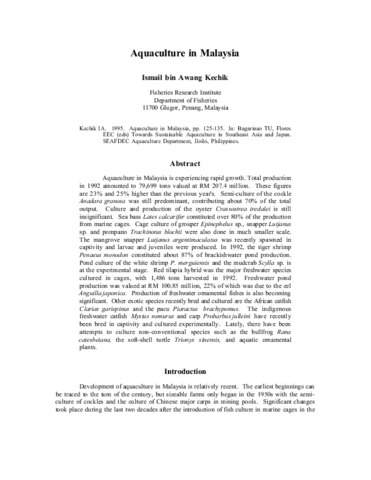Mangrove-associated mollusc research at SEAFDEC/AQD
- Global styles
- MLA
- Vancouver
- Elsevier - Harvard
- APA
- Help
Share
抄録
Mollusc research at the Aquaculture Department of the Southeast Asian Fisheries Development Center started in 1975 and focused on two commercially important mangrove-associated bivalves, the slipper-shaped oyster (Crassostrea iredalei) and the green mussel (Perna viridis). Studies conducted were on spatfall forecasting to increase collection of seeds from the wild; improvement of farming techniques; seed production in the hatchery; bivalve sanitation; and transplantation. These studies have led to the development of a suitable spat collector for oyster and mussel; promotion of the raft culture method for oysters and mussels to prevent siltation of growing areas, including a low-cost raft design for this purpose; refinement of transplantation techniques to increase production and to grow osyters and mussel in suitable areas without natural populations; and desgin of a prototype low-cost depuration unit.
A socio-economic study of oyster and mussel farming practices in Western Visayas provided information on current farming practices and profitability. A study done on the use of green mussel as biofilter in a semi-intensive shrimp pond showed that shrimp stocked with mussels grew faster than those without.
A study on the biology and fishery of the "imbao" Anodontia edentula, another mangrove-associated bivalve, is ongoing. Spawning has been achieved in the laboratory and larval stages monitored were first polar body, 2-cell stage, morula, ciliated gastrula, trocophore, veliger, and pediveliger.
Suggested Citation
de Castro-Mallare, T. R. (2000). Mangrove-associated mollusc research at SEAFDEC/AQD. In J. H. Primavera, L. M. B. Garcia, M. T. Castaños, & M. B. Surtida (Eds.), Mangrove-Friendly Aquaculture: Proceedings of the Workshop on Mangrove-Friendly Aquaculture organized by the SEAFDEC Aquaculture Department, January 11-15, 1999, Iloilo City, Philippines (pp. 177-183). Tigbauan, Iloilo, Philippines: Southeast Asian Fisheries Development Center, Aquaculture Department.
Type
Conference paperISBN
9718511423Collections
Related items
Showing items related by title, author, creator and subject.
-
Aquaculture industry profile and trends
Yap, Wilfredo G. (University of the Philippines Aquaculture Society, Inc., 2001) -
Aquaculture in Malaysia
Kechik, Ismail bin Awang. (Aquaculture Department, Southeast Asian Fisheries Development Center, 1995)Aquaculture in Malaysia is experiencing rapid growth. Total production in 1992 amounted to 79,699 tons valued at RM 207.4 million. These figures are 23% and 25% higher than the previous year's. Semi-culture of the cockle ... -
Coastal aquaculture in Thailand
Sahavacharin, Songchai (Aquaculture Department, Southeast Asian Fisheries Development Center, 1995)Coastal aquaculture in Thailand has expanded rapidly in both area and production in the last decade. The important cultured species are the shrimps (Penaeus monodon and P. merguiensis), sea bass Lates calcarifer, groupers ...







